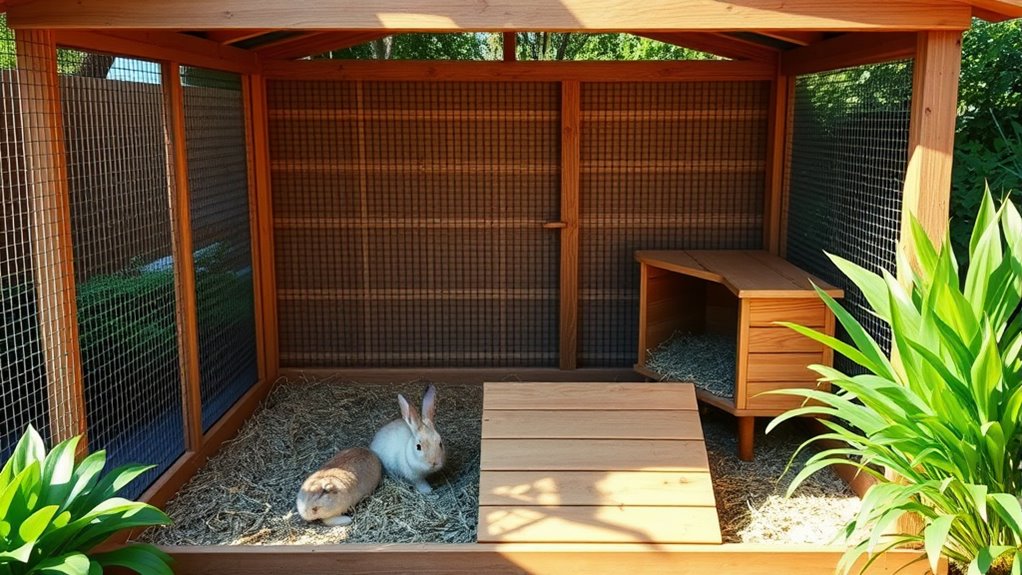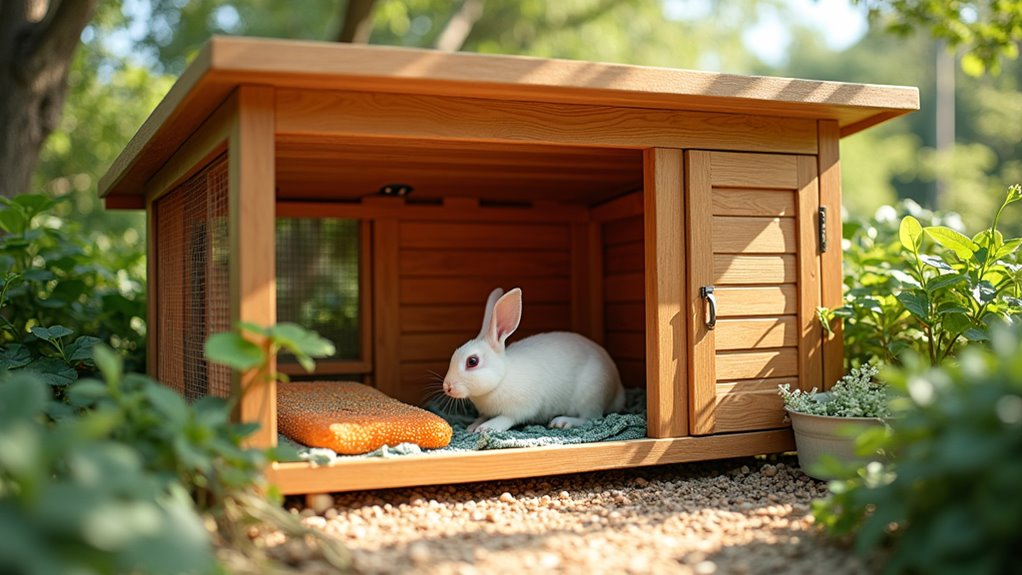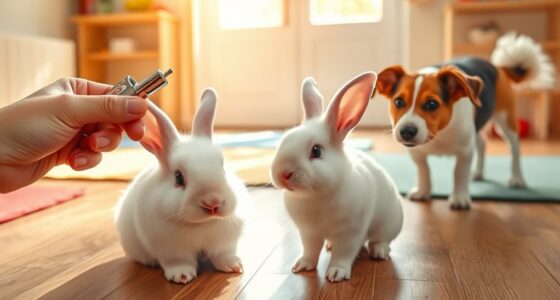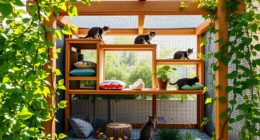To set up a comfortable home for your rabbit, choose a quiet, draft-free indoor spot with natural light or build a weather-resistant outdoor enclosure with sturdy materials and predator-proofing. guarantee the space is large enough for hopping and includes hiding spots, enrichment features, and safe plants. Secure all electrical cords and keep the environment clean and stimulating. For more tips on creating the perfect rabbit habitat, keep exploring this guide.
Key Takeaways
- Choose a quiet, draft-free indoor spot with natural light and stable temperature for a cozy rabbit home.
- Use weather-resistant, secure materials and elevate outdoor enclosures to protect from pests and dampness.
- Ensure all wiring is safely secured and hidden to prevent chewing hazards inside and outside.
- Provide natural elements, tunnels, and platforms to enrich your rabbit’s environment and encourage natural behaviors.
- Regularly inspect and clean the enclosure for safety, hygiene, and to maintain a stimulating, healthy habitat.

Building a safe and comfortable rabbit hutch or enclosure is essential for your bunny’s well-being. The first step is deciding on the best location for your rabbit’s home. If you plan to keep your rabbit indoors, placement matters just as much as the design of the enclosure. You want to choose a spot that’s quiet, away from direct sunlight, drafts, and noisy appliances. A corner of a room with stable temperature, good ventilation, and natural light is ideal. Indoor placement allows you to easily monitor your bunny, provide interaction, and keep it safe from predators and extreme weather conditions. This setup also minimizes the risk of exposure to pests or harsh outdoor elements, making it easier to maintain cleanliness and hygiene.
On the other hand, if you prefer an outdoor enclosure, you need to ensure it offers reliable outdoor protection. A well-constructed hutch outdoors should be elevated off the ground to prevent dampness and pests from entering. Use sturdy, weather-resistant materials to withstand rain, wind, and UV rays. The enclosure should have a solid roof to shield your rabbit from rain and direct sunlight, and walls that provide shelter from wind and predators. Ensure there’s enough space inside for your bunny to hop around comfortably, and include a shaded area to prevent overheating during hot days. It’s also wise to place the outdoor enclosure in a location that’s not overly exposed to the elements but still gets some sunlight and fresh air. Incorporating weather-resistant materials can help prolong the lifespan of the enclosure and better protect your rabbit from changing weather conditions. Additionally, adding enrichment features such as tunnels or platforms can promote natural behaviors and prevent boredom. Providing natural elements like grass or safe plants inside the enclosure can further enhance your rabbit’s environment.
Whichever option you choose, safety comes first. For indoor setups, secure all wiring and electrical cords out of reach to prevent chewing. For outdoor enclosures, reinforce entry points to keep out predators like dogs, foxes, or raccoons. Cover any openings with wire mesh that’s small enough to keep pests out but still allows for airflow. Regularly inspecting for damage and cleaning the enclosure helps keep your bunny safe and healthy. Additionally, understanding rabbit behavior can help you create a more enriching environment that promotes your bunny’s mental and physical health. Moreover, considering foraging opportunities within the enclosure can provide mental stimulation and a more natural environment for your rabbit.
Frequently Asked Questions
How Often Should I Clean My Rabbit’S Enclosure?
You should clean your rabbit’s enclosure at least once a week to maintain a healthy environment. Stick to a regular cleaning schedule, removing soiled bedding, leftover food, and waste daily to prevent odors and infections. Enclosure maintenance is essential for your rabbit’s well-being, so stay consistent. Deep clean the entire space, including cages and accessories, every 7-10 days to keep it fresh and safe for your furry friend.
What Safety Features Are Essential for Outdoor Rabbit Enclosures?
You need to prioritize safety features that protect your rabbit from outdoor risks. Make sure your enclosure has UV protection to shield your bunny from harmful rays and secure latches to prevent escapes and predators. Keep the enclosure sturdy and escape-proof, check for sharp edges, and guarantee there’s proper ventilation. By focusing on UV protection and secure latches, you create a safe, comfortable environment where your rabbit can thrive outdoors.
How Can I Prevent My Rabbit From Escaping?
To prevent your rabbit from escaping, make sure your enclosure has secure wire mesh that’s buried slightly into the ground to stop digging. Use sturdy enclosure locks on all doors and access points to avoid accidental openings. Regularly check for weak spots or damage in the wire mesh, and reinforce any vulnerable areas. By maintaining these safety features, you keep your rabbit safe and secure in its outdoor space.
What Type of Bedding Is Best for Comfort and Hygiene?
For comfort and hygiene, choose bedding materials like straw, hay, or paper-based products that absorb moisture and control odors. Avoid cedar or pine shavings, as they can be harmful to your rabbit’s respiratory health. Practice good hygiene by changing bedding regularly, cleaning the enclosure thoroughly, and removing soiled areas promptly. This keeps your rabbit comfortable, reduces odor, and promotes a healthy, happy environment.
How Do I Choose the Right Size Enclosure for My Rabbit?
Choosing the right enclosure size is like giving your rabbit a cozy castle to rule. You need enough space to comfortably hop and stretch, promoting healthy rabbit exercise. Look for enclosures made of durable, safe materials that provide ventilation and security. A good rule of thumb is at least 4 square feet of space per rabbit, with additional room for exercise, ensuring your furry friend has a happy, healthy home to thrive in.
Conclusion
Think of your rabbit’s hutch as a castle, a safe haven where they can freely explore and relax. When you provide a cozy, well-designed enclosure, you’re offering a sanctuary that nurtures trust and happiness. Just as a gardener tends to their plants with care, your attention creates a thriving environment. Remember, a comfortable home isn’t just about shelter—it’s the foundation for a joyful, healthy life for your furry friend.










